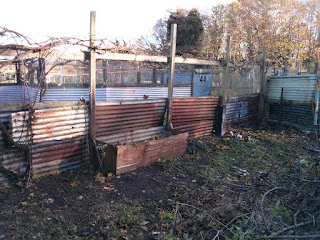Okay so if you read my post on pumpkins you may have seen me mention about waiting to hear about another (full sized) plot, well shortly after that we were given the larger plot we applied for, we will for next year anyway keep our smaller plot on as well as the new bigger plot, but at the end of next year we'll give up the smaller plot and just work the larger one.
So today I decided to make a start on getting it ready, there's lots to do, fences need fixing (most of which I've now done) I need to make a new gate and I have also at some point got to move all the stuff from the small plot to the large plot, like the shed and such like (that'll be fun) but for today it was just clearing and seeing what's what.
The plot -
So today I decided to make a start on getting it ready, there's lots to do, fences need fixing (most of which I've now done) I need to make a new gate and I have also at some point got to move all the stuff from the small plot to the large plot, like the shed and such like (that'll be fun) but for today it was just clearing and seeing what's what.
The plot -
 |
| Lots of weeds. |
You may well be wondering why I took the picture through this mesh, well you see the plot was locked with a big chain and padlock, so the first job was to actually get into it.
You shall not pass -
 |
| Okay, I see the problem. |
I had to cut through part of the gate to get it open, it doesn't matter as I'll be making another gate.
I'm in -
 |
| Doesn't look any better from here. |
This plot does come with some bonuses, the first being two large grape vines, one is huge and runs along the entire front of the plot, so I decided to tackle that first.
It's all in here somewhere -
 |
| Nettles everywhere. |
And after an hour or so of getting stung all over the place things were looking better -
 |
| Much improved. |
You can see the vine running along the top if the fence, I pruned this back and pulled up the nettles and other assorted weeds, it seems there's a compost bin here as well, although this will be taken out.
I plan to put the shed and a new compost bin along this fence, the area in the corner is quite shady so not so great for growing things, this will be where the shed goes, I did also have to repair some holes in this fence, and I've got to sort out a new gate posts as the ones already in are a bit wobbly.
The other grape vine pruned -
 |
| Bit hard to see. |
After thinking about it for a while I think I shall move this grape vine to a better location, it's kind of in an awkward place here, so it'll be moved closer to the other vine, near to where the shed will go.
Along with a fork and a shovel I also found some metal cages, a few people on the site use these for covering plants to stop the birds eating them, so I'll be able to use them as pigeon proofing.
Metal cages -
 |
| These will come in handy. |
I found some wood from an old apple tree, this has now been added to my wood turning supplies, they aren't thick pieces, but they'll do for making shawl pins and similar things.
In the past this particular plot had been vandalised, and the apple tree was cut down by the vandals so I'm putting the wood to good use, although I'm not sure why they chose to cut down that apple and leave the other two but there you go.
Turning supplies -
 |
| I'm sure I can make use of this. |
As well as the grape vines and the two apple trees there are also some currant bushes, in a bit of a poor state but at least one will survive once it's tidied up and there are at least two gooseberry bushes, again these need some tlc, but should be okay and there's some rhubarb plants (at least one, maybe more) and from what I can tell there are a few saplings around the plot, these may turn out to be fruit trees, they look like apples but I'll have to see.
And even though the one apple tree was cut down it's not dead, it's showing signs of new growth so I maybe able to get it to grow, but it'll be some time before it bears fruit, if at all.
Life finds a way -
 |
| Can't keep a good tree down. |
Well that was enough for one day, I spent longer there than I meant to, but I got a lot done, there's still lots to do in order to get the plot in a usable state before spring, more fixing of things and working out where things will go and then there's the digging, the whole plot needs digging over, I think there might even be a few rows of spuds still in the ground although they may not be usable, but you never know.
Here's what the plot looked like when I left -
 |
| I shall be having a large bonfire soon. |
Thanks for reading, and stay tuned for updates, I suspect this will keep me busy throughout the winter months.
























